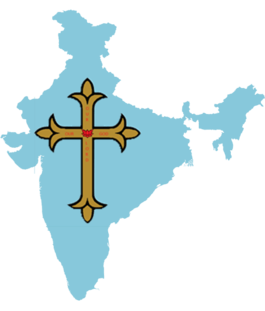Church of South India
| Church of South India | |
|---|---|
|
Logo of the Church of South India | |
| Classification | Anglican and Protestant |
| Orientation | Ecumenical |
| Polity | Episcopal[1] |
| Moderator | Govada Dyvasirvadam |
| Associations |
Anglican Communion, World Council of Churches, World Communion of Reformed Churches, Christian Conference of Asia, Communion of Churches in India, National Council of Churches in India |
| Region | Andhra Pradesh, Karnataka, Kerala, Tamil Nadu, Telangana and Sri Lanka (CSI churches in North India are under the respective CNI bishops. CSI churches in Europe are under the respective Anglican Bishops) |
| Origin |
27 September 1947 (Day of Union, not a day of establishment) Chennai, Tamil Nadu |
| Merger of | Anglican and Protestant including some Methodist, Presbyterian and Baptist |
| Separations | [Anglican Church of India] |
| Congregations | 14,000[2] |
| Members | 4,000,000[2] |
| Ministers | 11,214[3] |
| Hospitals | 104[2] |
| Secondary schools | 2000 schools, 130 colleges[2] |
The Church of South India (CSI) is the successor of a number of Protestant denominations in India, including the Church of England, the Methodist Church and the Church of Scotland after Indian Independence. It came into being by a union of Anglican and Protestant churches in South India.[4] It combined the South India United Church (union of the Congregationalists and the Presbyterians); the then 14 Anglican Dioceses of South India and one in Sri Lanka; and the South Indian District of the Methodist church[1] With a membership of over four million,[2] it is India's second largest Christian church after the Catholic Church in India.[5] CSI is one of three united churches in the Anglican Communion, the others being the Church of North India and the Church of Pakistan.
The inspiration for the Church of South India was born from ecumenism and inspired by the words of Jesus Christ as recorded in the Gospel of John (17.21). Just like the United Church of Christ (Congregationalist), one of their forbearer denominations, their motto is:
That they all may be one; as thou, Father, art in me, and I in thee, that they also may be one in us: that the world may believe that thou hast sent me.'
"That they all may be one" is also the motto of the Church of South India.[2]
History
Constituent churches
The Anglican presence in India dates back four hundred years to 1600, when Queen Elizabeth I was on the throne of England. From that time until within living memory British chaplains and missionaries arrived in ever-increasing numbers and were the first to minister to the expatriate British community.
The Diocese of Calcutta was promulgated in 1814; its territory included not only India but also those countries known today as Pakistan, Bangladesh, Myanmar (then Burma) and Sri Lanka (then Ceylon) and also, from 1824 to 1836, Australia. With the foundation of the Diocese of Madras in 1835 (mostly the current Church of South India including Ceylon and south east Asia) and the Diocese of Bombay in 1837 the Indian church was formed into a province, with the Bishop of Calcutta being metropolitan ex-officio.
With the growth of nationalism during the latter part of the 19th century, there also developed among Indian Christians a concern for self-reliance and independence. There was, further, the growing awareness that the divisions among the churches in India were not the making of Christians in India but brought by the different missions from abroad. However, faced with the challenge of the mission frontier and the necessity of better credibility, the churches began to be increasingly aware of the scandal of disunity and sought ways of overcoming it. As a result, different kinds of mergers or unions among churches were beginning to take place. In October 1901, a federal union took place between the Presbyterian missions in South India, the United Free Church of Scotland Mission, the American Arcot Mission of the American Dutch Reformed Church and the Basel Mission. In 1904, the Congregational churches of the London Missionary Society in South India and the Congregational churches of the American Board Missions in South India and Jaffna came together in a federal union. In 1908 these two bodies, the Presbyterian and the Congregational, came together to form the South India United Church (SIUC).
Following the World Missionary Conference held in Edinburgh in 1910, there was even greater impetus for co-operation and union among churches.[6] One of the direct consequences in India of the Edinburgh conference was the formation of the National Missionary Council in 1914 (which later became the National Christian Council of Churches).[7] The National Missionary Council organized regional Christian councils; one of the objectives of these was the strengthening of the evangelistic outreach as a joint or co-operative activity of all the churches. The experience of such joint evangelistic programs of the Madras Regional Council led the churches to raise the question afresh as to whether there was any valid reason for the churches to remain divided when they had the same Gospel of Jesus Christ to proclaim in their evangelistic mission. As a result of this realization, an informal meeting of pastors of the Lutheran, Methodist, South India United Church and Anglican churches, convened by Vedanayagam Samuel Azariah (later Bishop of Dornakal[8]) and V. Santiago, took place in Tranquebar in 1919. This notable conference on church union is known as "Tranquebar 1919".[9] The Tranquebar Manifesto was signed by Anglicans and the South India United Church. Six Anglican signatories were led by V.S. Azariah and 25 signatories from the South India United Church were led by V. Santiago.[10] The conference issued a call for union among the churches and a joint committee was set up for considering negotiations for union. The Lutherans did not join this committee and only the other churches, the Anglican, Methodist and the SIUC, participated in the negotiations which followed. The first meeting of the committee was held in 1920 and following it many meetings were held to consider different issues until the churches could agree on a common basis for union.
According to Bengt Sundkler, Professor of Missions at Uppsala University, Sweden, and late Research Secretary, International Missionary Council, "The two leading Indians from South India United Church were V. Santiago and Meshach Peter. It is significant that they were both connected with American Missions and not the products of British congregationalism. Santiago is a typical representative of the Madura-Pasumalai type of congregationalism of American origin. His views on Church Union were formed by his lifelong contact with G.S. Eddy and J.J. Banninga, the latter a Madura missionary who was to take a leading part in Church Union negotiations after 1919. Preacher, evangelist and musician, with a keen interest in finding Indian forms of worship, Santiago was the first Indian chosen as Moderator of the South India United Church and he also became its President. It was Santiago who approached Azariah to act as the convener for the Tranquebar conference."[11]
For the next ninety years, that is until 1927, the Church of India was a province of the Church of England under the authority of the Crown and the British Parliament. Vedanayagam Samuel Azariah was consecrated as the first native Indian bishop on December 29, 1912, at St. Paul's Cathedral, Calcutta. John Mott, the well-known missionary authority, who was present on the occasion, said that it was one of the most impressive ceremonies he ever witnessed.[12] There were no less than eleven bishops of the Province of India taking part in the act of consecration. Indians from all parts, and especially from the new bishop's own country of Tinnevelly, were present in large numbers. The real significance of the ceremony lay in the fact that Azariah was the first Indian to be consecrated a bishop of the Anglican Communion.[13] For the two years previous to his Consecration he had been Head of the Mission at Dornakal, started by the Indian Missionary Society of Tinnevelly.
On 22 December 1927, the British Parliament passed an enactment known as the Indian Church Act of 1927. The act (17&18 Geo.5, CH.40) makes the provision incidental to and consequential on the dissolution of the legal union between the Church of England, the Church of England in India, and the Church of England in Ceylon. The Province of the Church of India, Burma and Ceylon came under the administration of the Indian Church Act of 1927. Hence in 1927 a new, independent church was formed - the Church of India, Burma and Ceylon. Until 1927 the Province of India was the third province of the Church of England with its metropolitan establishment in Calcutta.[7]
Arising from the enactment of the Indian Church Measure and the Indian Church Act for the dissolution of its legal connection with the Church of England, the Church of India, Pakistan, Burma and Ceylon was governed by its own very comprehensive "Constitution, Canons, and Rules", commonly called "the Canons".
Origins
The Church of South India Scheme was the first practical attempt of its kind towards reunion, on the basis of the points enunciated in the Chicago-Lambeth Quadrilateral:
- The Holy Scripture of the Old and the New Testaments as containing all things necessary to salvation and as being the rule and ultimate standard of faith.
- The Apostles' Creed as the Baptismal Symbol and the Nicene Creed as sufficient statement of the Christian faith.
- The two sacraments, ordained by Christ Himself — Baptism and the Supper of the Lord — ministered with the unfailing use of Christ's words of Institution and elements ordained by Him.
- The Historic Episcopate, locally adapted in the methods of its administration to the varying need of the nations and people called of God into the union of His Church.
When the Church of South India was formed, it was not the formation of a new church. It sought rather to bring together the distinctive elements of different Christian communions on a basis of sound doctrine and episcopal order in a distinct province of the Universal Church.
The different denominations which came into the United Church:
- Church of South India, Burma and Ceylon (Anglican Communion)
- British Methodist Church
- Presbyterian
- Congregational
(The Presbyterian and Congregationalists were already united as the South India United Church(SIUC))
Four different church traditions were brought together in the CSI, Anglican (Episcopal), Congregational, Presbyterian and Methodist. All these churches had been established in India through the missionary work of churches in Europe, America and Australia, which had started their work in India at different periods from the beginning of the 18th century.
Anglicanism was established through the work of the Church Missionary Society (CMS))[14] and the Society for the Propagation of the Gospel (SPG), both closely linked with the Church of England. The Congregational churches were established through the missionary activities of the London Missionary Society with missionaries from Great Britain and Australia, and the American Board of Commissioners of Foreign Missions (ABCFM). The Presbyterian churches were established through the work of the Church of Scotland Mission, the Dutch Reformed Church in America and the Basel Mission in Switzerland and Germany. They also had connections with the Presbyterian churches in England and Australia. The Methodist Church was established by the Methodist Missionary Society of the Methodist Church in Great Britain.
It was in 1928 that a few Indian leaders of the church under the leadership of Vedanayagam Samuel Azariah met in Tharangambadi. The Indian leaders with one mind spent several days in retreat interceding for guidance. Quite early in the negotiations it was agreed that the Lambeth Quadrilateral could be a satisfactory basis for the union of the churches. This meant that the four basic principles would be: (1) the Holy Scriptures of the Old and New Testament as containing all things necessary to salvation and as the supreme and decisive standard of faith; (2) the two creeds, the Apostles' Creed and the Nicene Creed as witnessing to and safeguarding this faith; (3) the two Sacraments of Baptism and the Lord's Supper, and (4) the ordained ministry with the historic episcopate.
The first three could be accepted without any controversial question. But the fourth became problematic because of the fact that while the Anglican Church had the historic episcopate, and all its ministers were ordained by the episcopal laying on of hands, the other churches in the negotiations did not have an episcopal ordained ministry. Finally, an agreement was reached that in so far as God had blessed all the ministries with undistinguished regard, all who were already ordained in any of the uniting churches would be received as ministers in the United Church and that all new ordinations would be by episcopal laying on of hands.
It took about 20 years to reach the agreement. It took a few more years for the churches to take their formal decisions accepting the scheme of union. The Methodists gave their vote in 1941. In 1945, the General Council of the Church of India, Burma and Ceylon (the Anglican Church) gave their consent for the four Anglican dioceses in South India to go into the union. In 1946, the General Assembly of the South India United Church decided to accept the scheme. These decisions made it possible for the Church of South India to be inaugurated on 27 September 1947.[15] Faiths Over the bowed heads of missionaries and natives in St George's Cathedral in Chennai, India on 27 September 1947 rose the prayer of a minister: "Hasten the time, O God, when throughout the world there shall be one flock." His prayer was that day being answered for one section of the world. Protestant denominations in south India had at last buried their differences and were joining in one Christian Church, The Church of South India. The inauguration was a historic and spiritual occasion uniting the four denominations as one united Church. This was one of the largest and the most inclusive Protestant unions in history. It numbered more than a million Indian Christians; Anglicans, Methodists, Congregationalists, Presbyterians and members of the Dutch Reformed Church, all the fruit of 250 years of endeavour by British missionaries to spread the gospel in India.
Altogether 15 bishops were consecrated into the new Church of South India. To present a united front even the austere Presbyterians wore the prescribed white cotton robes with saffron stoles, a colour they borrowed from India where the Hindus regard it as holy. Each bishop was consecrated when nine ministers of the uniting churches laid their hands upon his head. In written statements solemnly placed on the altar of the cathedral, all denominations made concessions. The tradition-minded Anglicans, though they have always believed that their priests can trace an unbroken line of succession from St Peter, agreed to recognize the authority of the ministers who had broken away from the line of succession.[16]
The strangest compromises came with the touchy matters of church government. Before the Calvinists would agree that the church should have any bishops at all, they insisted that there be installed a chief bishop to be known by the familiar Calvinist title of Moderator and to be addressed as "Most Reverend" (ordinary Anglican bishops are merely known as "Right Reverend"). However, each church retained the right to practise its customary forms of worship for a period of 30 years.
The founders of the uniting church wanted to have a period of 30 years before its full consummation, so it accepted presbyters ordained by the different denominations without any reordination or unifying service; this is one of the unique features of the church. The Church of North India (CNI) held a unification service as it wanted all the presbyters to be unified at the time of the inauguration, but the CSI provided for a period of 30 years for natural unification. During the 30-year period all the presbyters were treated alike and served in Anglican and non-Anglican pastorates without any distinction.
Formation
The Church of South India union ceremony happened at St George's Cathedral in Madras on 27 September 1947, a month after India achieved its independence from the United Kingdom. It was formed from the union of the South India United Church (itself a union of churches from the Congregational Presbyterian and Reformed traditions); the southern provinces of the Anglican Church of India, Pakistan, Burma and Ceylon; and the Methodist Church of South India.[17]


The presiding bishop of the inaugural function was C. K. Jacob of the Anglican Diocese of Travancore and Cochin. A vast congregation gathered in the cathedral at Madras from all over the world. The following historical declaration was made by Jacob at the inaugural.[18]
Dearly beloved brethren, in obedience to the Lord Jesus Christ the head of the church, who on the night of his passion prayed that his disciples might be one, and by authority of the governing bodies of the uniting churches whose resolutions have been read in your hearing and laid in your prayer before Almighty God; I do hereby declare that these three churches, namely – the Madras, Madura, Malabar, Jaffna, Kannada, Telugu, Travancore Church councils of the South India United Church; the Methodist Church of South India, Trichinopoly, Hyderabad and Mysore districts; the Madras, Travancore and Cochin, Tinnevelly and Dornakal dioceses of the Churches of India, Burma and Ceylon; are become one Church of South India, and these bishops, presbyters, deacons and probationers who have assented to the basis of union and accepted the constitution of the Church of South India, whose names are laid upon this holy table, are bishops, presbyters and deacons of this church. In the name of the Father, and the Son, and the Holy Spirit, Amen.[18]
By the independence of India in 1947, the union was achieved and the CSI officially established. Leaders said that the Church of South India was conceived in 1928 at Tharangambadi and born at St. George's Cathedral, Chennai on 27 September 1947, after twenty-eight years of prayer and discussion.
The inauguration of the Church of South India opened a new chapter in the history of the churches. This was the first time in history such a union was realised between episcopal and non-episcopal churches. By this union four traditions came together, i.e., Anglican (Episcopal), Congregational, Presbyterian and Methodist.[19]
When the Church of South India was inaugurated there were fourteen dioceses. Today the church has twenty-four dioceses and more than five million members. There are eight dioceses in Tamil Nadu, six in Andhra Pradesh, six in Kerala, three in Karnataka, and one in Sri Lanka.
In the 1990s, a small number of Baptist and Pentecostal churches also joined the union.[2] In 2013, the Church of South India appointed Eggoni Pushpa Lalitha, the first woman to become a bishop in India.[20] She was appointed to the Nandyal Diocese of the Church.[21]
Logo
The logo of the Church of South India was designed by Prof.J. Vasanthan of The American College in Madurai.The logo of the CSI is a cross superimposed on a stylized lotus and surrounded by the motto and the name of the church.The symbols of the lotus and the Christian cross used in the logo possess a rich cultural heritage in India and are used to symbolize the call and mission of the CSI.
In Indian mythology, the lotus flower is the seat of the Creator. It is also known variably as those that are born in mud and the flower of the sun. These symbolisms are adopted to interpret the position of God and the nature and role of the people in the CSI.
The petals of the lotus and the cross are knitted together with the symbol of the fiery-tongues of the Holy Spirit as described in the book of the Acts of the Apostles. It is an expression of the people's communion with God. The original colours, red (for life) and purple (for piety and ecclesiastical) on a white backdrop communicate the nature of the mystical union where an inseparable companionship is established between God and humanity.
The motto and the name of the CSI is placed in a circle around the lotus and the cross. The words are taken from the prayer of Jesus Christ who prayed not only for the church but also for the whole world. This universality is portrayed by placing the words in a form of circle, a symbol which also represents the universe. It calls for the unity of both the church and all peoples of India.
The central position of the cross in the logo conveys the idea that it was the sacrifice made by Jesus on the cross that is the foundation of the Church. The four ends of the cross painted in deep colour indicates that it is the cross that guides all Christians to join in one stream to pray and work together, united for a peaceful coexistence and communal harmony.
Beliefs and practices
The Church of South India is a trinitarian church that draws from the traditions and heritage of its constituent denominations. The basic creeds of the Church of South India are the Apostle's Creed and the Nicene Creed of 381 AD.The CSI practises infant baptism for children born in Christian homes. For others, believers or adult baptism is given. Baptized children are members of the church and share in the privileges and obligations of membership so far as they are capable of doing so. The full privileges and obligations belong to those who, after attaining to years of discretion, receive confirmation of their baptism. Normally, members are confirmed by the laying on of hands by a bishop. Confirmation may also be given by a presbyter authorized to do so.
Social issues
Regarding ordination and social issues, the CSI has a tendency to be more liberal than other churches in the Global South. In 2013, the CSI consecrated its first female bishop, the Rev. Eggoni Pushpalalitha.[22] Likewise, relating to human sexuality, the CSI is more accepting of diversity of opinion. "The Church of South India (CSI) [is] a relatively liberal Protestant church which has, since 1984, allowed women to become pastors. 'CSI has been liberal on these issues. It has taken up issues of gender, dalits and landlessness. It has to address the issue of sexual minorities too'".[23] In 2009, the Rev. Christopher Rajkumar spoke out in favour of gay rights.[24] Also in 2009, Bishop V. Devashayam "gave a favorable impression" of gay rights.[25]
Moreover, in 2015, St. Mark's Cathedral in Bangalore hosted an event, co-led by the Rev. Vincent Rajkumar, aimed at denouncing homophobia.[26] CSI clergy, working with the National Council of Churches in India, also co-led a consultation speaking out against homophobia.[27] Currently, the Church of South India is also listed as among the Anglican provinces open to blessing same-sex couples.[28] In August 2016, the CSI's publication expressed concern that the "Christian church and Christian mission to a large extent are homophobic. It has excluded the gender minorities from the church and its worship".[29]
On transgender issues, the Diocese of Madras has a ministry specifically for transgender people.[30] Moreover, the CSI has opened up ordained ministry to transgender clergy.[31] In 2012, the denomination invited a transgender pastor to preach.[32] The CSI also published resources for special Sunday celebrations for transgender people including an invitation for transgender members to preach in churches.[33]
The church, via its monthly publication, has also taken a stance of solidarity with the Dalit community, women, and the LGBT community. One ministry, led by a priest, "took a session on 'working towards an inclusive Church' with special reference to the transgenders", and the church celebrates the "self-liberation" of the Dalit community.[34] Additionally, the church's publication stated that "the Church leaders expressed their concerns about the neglected people such as LGBT and those affected and infected with HIV/AIDS...[and] urged the listeners(Church Leaders)...[to] not only show solidarity but also moving beyond in accommodating them".[35]
The CSI also opposes the death penalty.[36]
Liturgy
The liturgy of the Church of South India combines many traditions, including that of the Methodists and such smaller churches as the Church of the Brethren and the Disciples of Christ. After the formation of the Church of South India the first synod met at Madurai in March 1948 and appointed a liturgical committee. The first Synod in 1948 (where the Holy Communion service was that of the Presbyterian Church of Scotland) appointed a liturgy committee, composed mainly of Western theologians. The liturgy so prepared was first used at the Synod Session in 1950 and approved for use throughout the church "wherever it is desired" in 1954. The first version of the Confirmation Service for the new church was also released in 1950, translated into regional languages and was quickly adopted by the various dioceses.
By 1962 the Liturgy Committee was able to prepare a number of Orders. They were Eucharist, Morning and Evening Prayer, Marriage Service, Burial Service, Ordination Service and Covenant Service (1954), Holy Baptism (1955) and Almanac (1955–56). The Book of Common Worship of the CSI was published in 1963 with all the above orders of service. The orders of service consist of: Order for Morning and Evening Worship, Order of Service for the Baptized Persons, Order for Holy Baptism, Order for the Churching of Women, Order for Holy Matrimony, Order for the Burial Service, Order for the Covenant Service, Order for Ordination Services.
The CSI liturgy was again revised in the year 2004 and published as a hardback book in 2006.
The CSI Synod Liturgical Committee has developed several new orders for worship for different occasions. The order for the Communion Service, known as the CSI Liturgy, has been internationally acclaimed as an important model for new liturgies. The Committee has also produced three different cycles of lectionaries for daily Bible readings and "propers", and collects for Communion services. In addition, the Committee has also brought out a Supplement to the Book of Common Worship.CSI Liturgy
Festivals
The important festivals are Passion Week, Good Friday, Easter and Christmas. During the month of December, Christmas carol services are performed in churches. Harvest Festivals are also conducted in churches in the Church of South India; the main aim of harvest festival is to celebrate the harvest of that year and to give thanks to God.
Constitution
The Constitution of the CSI is the key document that governs the administration and management of the church. It comprises 14 chapters detailing rules for the functioning of the church at every level, from the local congregation to the pastorate, diocese and the Synod. The Preamble to the CSI Constitution starts with the words “We the members of the Church of South India affirm that this church is part of the one Holy, Catholic and Apostolic Church ” and concludes with a members’ “pledge to follow and uphold the Governing Principles of our Church and the provisions of this Constitution for the glory of God, the good of the Church and the welfare of all people.”
The Constitution came into effect when representatives of the three uniting churches that formed the CSI each laid a signed copy of it on the table of St. George’s Cathedral in Chennai during the founding service on 27 September 1947. Work on the Constitution had started in 1929 as part of the effort of the Joint Committee on the “Scheme of Church Union in South India” and concluded in 1941 when the seventh revision of the Scheme was published. First printed as ‘The Constitution’ in 1952, the document has been amended six times with reprints containing amendments published in 1956, 1963, 1972, 1982, 1993 and 2003.
The most important part of the CSI Constitution is “The Governing Principles of the Church” which sets out 21 governing principles on which the other chapters of the Constitution and the rules contained therein rest. While amending any part of the Constitution can be approved by a two-thirds majority of the Synod, amending the Governing Principles requires a three-fourths majority.
Ecumenism
The Church of South India is a member of the Anglican Communion and its bishops participate in the Lambeth Conferences; it has representation on the Anglican Consultative Council. It is also a member of the World Council of Churches, the World Alliance of Reformed Churches, and the National Council of Churches in India. The CSI is in full communion with the Malankara Mar Thoma Syrian Church of India and the Church of North India (CNI).
Following the formation of the Church of North India in 1970, these three churches which have bishops as their heads, began discussions on closer cooperation with the possibility of full union at a later date. A Joint Theological Commission (JTC) established for this purpose at its first meeting in Madras in 1975 defined its objective as “To explore the possibilities of closer cooperation between the three churches and to discuss questions of faith and order and other relevant issues so that they may be led to eventual Union keeping in mind the ultimate goal of all Christ’s people in India for the fulfillment of the Mission of the Church.”
The Church of South India (CSI), Church of North India (CNI), and Malankara Mar Thoma Syrian Church of India jointly formed the Communion of Churches in India (CCI) in 1978 for mutual recognition of the ministry and leaders, inter communal relationship, and to explore possibilities of working together especially in the field of evangelization in India and other areas of cooperation in the fulfillment of the mission of the Church. Later, the Methodist Church in India is also joined the Communion.
The Church of South India maintains a partnership with the Church of North India, Church of Scotland, Episcopal Church, Mar Thoma Syrian Church of Malabar, Methodist Church of Great Britain, Presbyterian Church in Korea, Presbyterian Church in the Republic of Korea, Presbyterian Church of India, Presbyterian Church (USA), Reformed Church in America, United Church of Christ, and the Uniting Church in Australia.[37]
Administration
The church accepts the Lambeth Quadrilateral as its basis and recognises the historical episcopate in its constitutional form.[3] The Church of South India is the second largest church in India based on the population of members, next to the Roman Catholic Church, and also the largest Protestant denomination in the country.
Synod
The church is governed by a synod based in Chennai and headed by a presiding bishop bearing the title of Moderator who is elected every two years. The ordinary session of the synod is held once every two years.
The current Moderator of the Church of South India is G. Dyvasirvadam, Bishop of Krishna-Godavari Diocese. The Deputy Moderator is Thomas K Oommen, Bishop of the Madhya Kerala Diocese.
Dioceses
The church is further divided into twenty four dioceses, each under the supervision of a bishop, including one diocese encompassing Jaffna, Sri Lanka. The dioceses are governed by diocesan councils composed of all clergy in the diocese as well as lay people elected from the local congregations.[38] Each church will have representation in diocesan council based on their membership. The diocese is headed by the Bishop, who is a presbyter elected through the Diocesan Council. He is considered as the head of the diocese and all the institutions belonging to the diocese. Other than the Bishop, the following are the important administrative posts of each diocese:
- Clergy Secretary : Manages all the activities of the pastoral & evangelical workers in the diocese
- Lay Secretary : Manages all the lay workers' activities in the diocese
- Educational Secretary : Manages all educational institutions and the workers of those institutions
- Diocesan Treasurer : Manages all the income and expenditures of the diocese.
The Diocesan Council also consists of Diocesan Executive Committee, Diocesan Standing Committee, and Pastorate Committee.
List of dioceses

Congregations
The church has 15,000 local congregations with 4 million members worldwide. While the majority of the members are in India, congregations exist in Sri Lanka where a full diocese is organized, the United States, the United Kingdom, Australia, Canada, Bahrain, Kuwait, Qatar and the United Arab Emirates. Church of South India members also worship in different parts of India including Bhopal, New Delhi, Kolkata, Bhilai, Mumbai, Pune and Bangalore.
Institutions under Church of South India
The church runs 2,300 schools, 150 colleges and 104 hospitals in South India. In the 1960s the church became conscious of its social responsibility and started organising rural development projects. There are 50 such projects all over India, 50 training centres for young people and 600 residential hostels for a total of 50,000 children.[2] The School for Small Farmers is a specific agency catering to the needs of the farming communities in their Dalit and Adivasi congregations.
Church of South India Trust Association
Church of South India Trust Association was constituted as a legal holding body of the movable and immovable properties of the Church of South India. The CSI-TA was registered in September, 1947 under Section 26 of the Indian Companies Act 1913 (now Section 25 of the Indian Companies Act 1956) as a Religious and Charitable Company which has no business character and with no profit motive. The properties of the Churches in Union have been transferred to CSI-TA. The main objectives of the Trust are:
- To act as Trustees for the CSI and accordingly to acquire and hold immovable and movable properties for the purpose of the Trust within the territory of India.
- To aid and further the work of CSI and in particular to assist pecuniarily and otherwise all or any of the Societies, Schools, Colleges, Hospitals, Institutions and other Charities which exist in connection with the said Church.
- To act as Trustees for the maintenance of the Church, Bishops, and other workers of the Church.
Affiliations
Theological education
The church recognizes theological degrees granted by institutions affiliated with the Board of Theological Education of the Senate of Serampore College. These include:
- Kerala United Theological Seminary (KUTS), Trivandrum
- Mennonite Brethren Centenary Bible College (MBCBC), Shamshabad, Hyderabad
- Andhra Christian Theological College (ACTC), Hyderabad
- Gurukul Lutheran Theological College & Research Institute (GLTCRI), Chennai
- Tamil Nadu Theological Seminary (TTS), Madurai
- Union Biblical Seminary (UBS), Pune
- United Theological College, Bangalore (UTC)
- South Asia Theological Research Institute (SATHRI), Bangalore
- Karnataka Theological College (KTC), Mangalore
- Bishops College (BC), Calcutta
- Serampore College (SC), Serampore
Growth
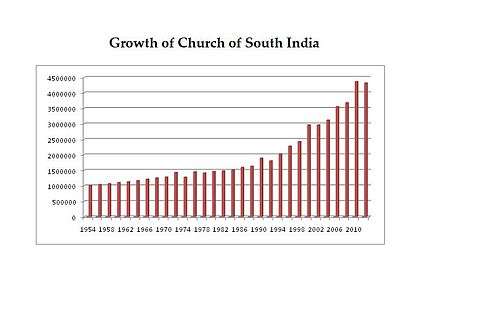
Gallery
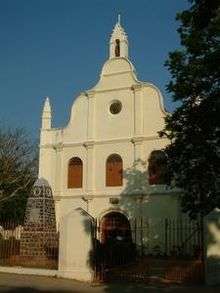
St. Francis CSI Church, in Kochi
Oldest church under the auspices of the Church of South India
CSI Christ Church, Alappuzha
Oldest church under the auspices of the Diocese of Madhya Kerala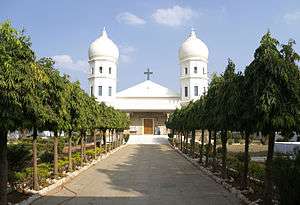
Epiphany Cathedral, Dornakal Diocese 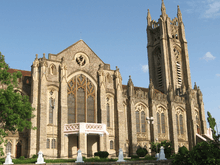

Holy Trinity Cathedral Palayamkottai,
Tirunelveli Diocese
St. George's Cathedral, Chennai
Madras Diocese
St. Mary's Church, Chennai
Oldest Anglican church in India


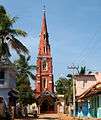
Holy Trinity C.S.I.Church in Pragasapuram, Thoothukudi - Nazareth Diocese 
St. John's C.S.I.Cathedral, Nazareth
Thoothukudi - Nazareth Diocese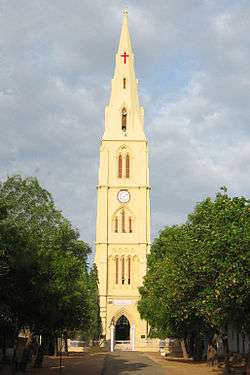
St Michael and all Angels C.S.I. Church, Mudalur
Thoothukudi - Nazareth Diocese
St. John's C.S.I. Church, Secunderabad circa 1890
It is the oldest church in Hyderabad
Holy Trinity C.S.I. Church, Bolarum
It was commissioned by Queen Victoria of the United Kingdom
Holy Trinity CSI Cathedral, Kottayam Madhya Kerala Diocese.jpg)
St. John's C.S.I. Church, Adayal Mudalur 
See also
- Church of North India
- Christianity in India
- Christianity in Kerala
- Christianity in Tamil Nadu
- Telugu Christian
- Communion of Churches in India
- St. Thomas Christians
- Malankara Mar Thoma Syrian Church
References
- 1 2 "www.oikoumene.org/en/member-churches/church-of-south-india". Oikoumene.org. Retrieved 2014-08-15.
- 1 2 3 4 5 6 7 8 "Church of South India International Resource Center". 2007. Retrieved 11 January 2013.
- 1 2 "World Council of Churches – The Church of South India". Retrieved 2008-06-21.
- ↑ Author:Sushil Mittal, Gene Thursby -Religions of South Asia: An Introduction
- ↑ "Operation World – India". Archived from the original on 2008-06-06. Retrieved 2008-06-21.
- ↑ Noel Davies, Martin Conway; World Christianity in the 20th Century, p. 134.
- 1 2 History of Church of South India
- ↑ Sundaram, K. J. G. (February 1931). "A Deccan Village in India". Journal of Geography. 30 (2): 49–57. doi:10.1080/00221343108987303.
- ↑ "Church of South India International Resource Centre". Retrieved 2008-06-21.
- ↑ Church of South India -The Movement Towards Union 1900-1947. Sundkler, Bengt, Prof.of Missions, Uppsala University, Sweden; late Research Secretary, International Missionary Council. Lutterworth Press, London pg. 103
- ↑ Sundkler, Bengt. Church of South India - The Movement Towards Union 1900-1947, p. 98. Lutterworth Press, London.
- ↑ [Collins, Paul M. Christian Inculturation in India, pp. 40-58. Burlington, Vermont: Ashgate Press, 2007.]
- ↑ Chatterton, Eyre. The Diocese of Dornakal, 1912. A Diocese of Mass Movements. IN,: Project Canterbury: A History of the Church of England in India since the early days of the East India Company, London, SPCK, 1924
- ↑ "The Church Missionary Atlas (India)". Adam Matthew Digital. 1896. pp. 95–156. Retrieved 19 October 2015. (subscription required (help)).
- ↑ Author:Roshan Dalal The Religions of India: A Concise Guide to Nine Major Pages 89-90
- ↑ [Rajaiah David Paul -The First Decade: An Account of the Church of South India Pages 6-42]
- ↑ "Anglican Communion official website – The Church of South India (United)". Retrieved 2008-06-21.
- 1 2 "Contact Support". Csichurch.com. Retrieved 2014-08-15.
- ↑ Author:Stephen Neill- From Edinburgh to South India
- ↑ "India appoints its first woman bishop | Anglican Ink 2014 ©". Anglicanink.com. 2013-09-28. Retrieved 2014-08-15.
- ↑ "India gets first woman Anglican bishop from Andhra - The Times of India". Articles.timesofindia.indiatimes.com. 2013-09-28. Retrieved 2014-08-15.
- ↑ ACNS staff. "Church of South India appoints first female bishop". episcopaldigitalnetwork.com. Episcopal Digital Network. Retrieved January 12, 2016.
- ↑ "Rising cases of sexual abuse within the church in Kerala force clergy to rethink on homosexuality". indiatoday.intoday.in. Retrieved 2016-04-29.
- ↑ Paul, Cithara. "Protestants support gay rights". telegraphindia.com. Telegraph. Retrieved January 12, 2016.
- ↑ deepak. "Church pressed to rethink and embrace the LGBT community". www.efionline.org. Retrieved 2016-08-26.
- ↑ Silthou, Makepeace. "A Theological Challenge to Christian Homophobia". thewire.in. The Wire. Retrieved January 12, 2016.
- ↑ "International Consultation on Church and Homophobia". Joseph N. Goh. 2014-12-08. Retrieved 2016-05-23.
- ↑ "Church split over homosexuality would be a failure - Welby". bbc.com. BBC. Retrieved January 12, 2016.
- ↑ "Horizons of Freedom" (PDF). CSI Life: Magazine of the Church of South India. 14.
- ↑ "Church of South India | CSI Chennai Diocese | CSI Diocese of Madras". www.csimadrasdiocese.org. Retrieved 2016-04-29.
- ↑ "CSI to ordain transgender a priest". The Hindu. 2012-02-06. ISSN 0971-751X. Retrieved 2016-04-29.
- ↑ "Transgender in a fix over spiritual path - Times of India". The Times of India. Retrieved 2016-05-01.
- ↑ "CSI SYNOD". www.csisynod.com. Retrieved 2016-10-25.
- ↑ Samuel, Joseph; Victor, James Cecil (February 2016). "CSI Life" (PDF). Magazine of the Church of South India. XIV (2). Retrieved July 2016. Check date values in:
|access-date=(help) - ↑ "Church Leaders and Key Affected People: A Dialogue" (PDF). CSI Life: Magazine of the Church of South India. XIII (5). May 2015. Retrieved July 2016. Check date values in:
|access-date=(help) - ↑ "CSI SYNOD". www.csisynod.com. Retrieved 2016-10-25.
- ↑ "CSI SYNOD". www.csisynod.com. Retrieved 2016-07-25.
- ↑ "About Kanyakumari Diocese". Retrieved 2008-06-21.
- ↑ "South India-Trichy-Tanjore". Anglican Communion. Retrieved 2014-08-15.
External links
| Wikimedia Commons has media related to Church of South India. |
- CSI Synod
- Church of South India, General Secretary
- Church of South India, Dallas, Texas, USA
- Church of South India, Toronto, Ontario, Canada
- Church of South India, Bangalore, Karnataka, India
- Church of South India, Chennai, Tamil Nadu, India

